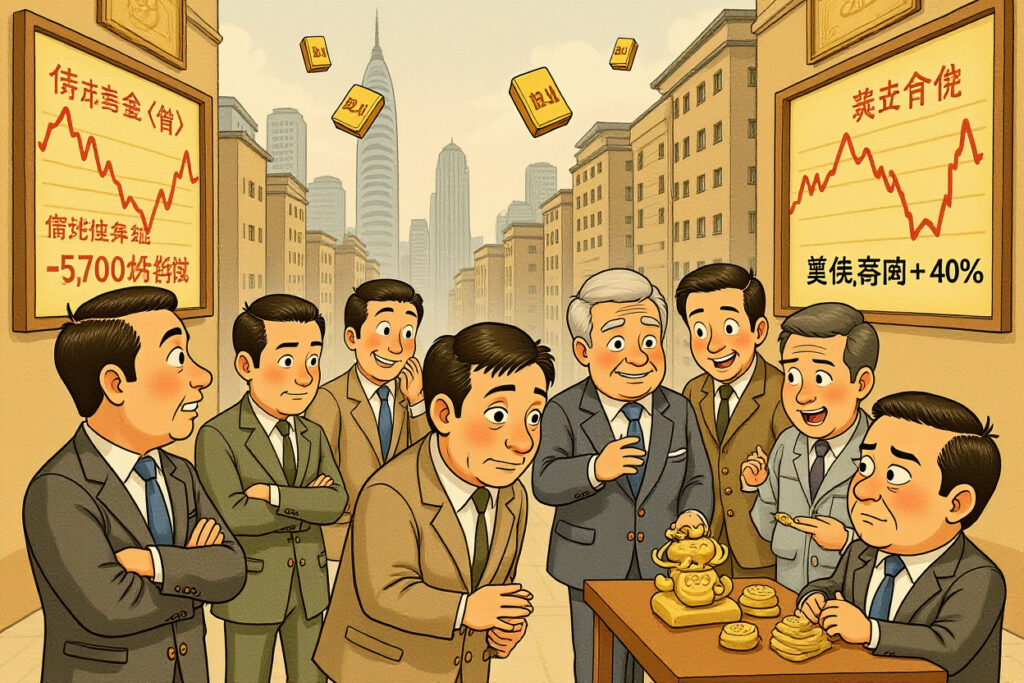Executive Summary
- Gold prices experienced a sharp, unexpected decline, dropping over 4% in intraday trading amid shifting global risk sentiment and dollar strength.
- China’s A-share market witnessed heightened volatility, with the 上证指数 (Shanghai Composite Index) falling 1.8% as sector rotations accelerated.
- Regulatory signals from 中国人民银行 (People’s Bank of China) and 中国证监会 (China Securities Regulatory Commission) suggest tighter oversight of speculative trading.
- Global institutional investors are reassessing exposure to Chinese equities amid evolving macroeconomic crosscurrents.
- Technical indicators suggest potential support levels for gold near $1,800/oz while A-shares face critical testing of 3,200-point threshold.
Financial markets confronted a dramatic repricing event as gold futures collapsed while Chinese equities abruptly reversed direction. This sudden market reversal caught many participants off-guard, triggering cascading effects across asset classes. The simultaneous movement in traditionally uncorrelated assets suggests deeper structural shifts occurring beneath surface-level price action.
The Gold Selloff: Technical Breakdown and Fundamental Drivers
Spot gold prices tumbled to three-month lows, breaching multiple technical support levels in a violent downward move. The selling pressure accelerated during Asian trading hours, coinciding with unexpected strength in the U.S. dollar index and rising Treasury yields.
Key Pressure Points
Several factors converged to drive the precious metal’s decline. First, hawkish commentary from Federal Reserve officials reinforced expectations of prolonged higher interest rates, diminishing gold’s appeal as a non-yielding asset. Second, reduced geopolitical tensions temporarily reduced safe-haven demand. Third, technical selling triggered automated strategies once critical support at $1,850/oz was breached.
Market data revealed unusually high volume during the decline, with over 2 million contracts trading hands on the COMEX exchange. This volume surge represented a 40% increase over the 30-day average, indicating broad-based participation in the move.
A-Share Volatility: Sector Rotation and Regulatory Context
China’s domestic equity market experienced simultaneous turbulence, with the 沪深300指数 (CSI 300 Index) declining 2.1% amid heavy selling in technology and consumer discretionary names. The sudden market reversal interrupted what had been a steady upward trend throughout the previous month.
Regulatory Developments
Market participants attributed part of the volatility to evolving regulatory guidance. 中国证监会 (China Securities Regulatory Commission) issued new margin trading requirements while 中国人民银行 (People’s Bank of China) maintained slightly tighter liquidity conditions through its open market operations. These subtle policy adjustments signaled authorities’ attention to potential asset bubbles in certain sectors.
Notably, the 科技创新板 (STAR Market) underperformed the broader market, declining 3.4% as investors rotated toward traditional industrial and state-owned enterprises. This rotation pattern suggests changing risk preferences among domestic institutional investors.
Global Macroeconomic Crosscurrents
The synchronized moves across asset classes reflect broader macroeconomic tensions. Rising global inflation expectations have forced central banks to maintain tighter monetary policies, while slowing growth in Europe and emerging markets creates conflicting signals for risk assets.
Currency Impact
The U.S. dollar’s strength particularly affected emerging market assets, with the 人民币 (Renminbi) experiencing moderate pressure against the greenback. The 美元/人民币 (USD/CNY) exchange rate moved toward the upper bound of its trading band, prompting suspected intervention from Chinese authorities.
Analysis of currency flows indicates foreign investors reduced exposure to Chinese equities through Stock Connect programs, with net outflows of approximately $1.2 billion recorded during the volatility episode. This represents the largest single-day outflow in three months.
Institutional Response and Positioning Changes
Major asset managers and hedge funds adjusted portfolios significantly in response to the sudden market reversal. Goldman Sachs analysts noted increased hedging activity among international investors exposed to Chinese equities, while domestic mutual funds faced redemption pressures particularly in technology-focused products.
Strategic Shifts
Portfolio managers emphasized quality factors and cash flow stability during the turbulence. Companies with strong balance sheets and domestic revenue focus outperformed those with international exposure or higher leverage ratios. This quality tilt suggests a more cautious approach to Chinese equity allocation despite attractive valuations.
Several large institutions increased allocations to Chinese government bonds during the equity volatility, seeking shelter in fixed income assets. The 10-year Chinese government bond yield compressed 15 basis points as demand for safety increased.
Technical Analysis and Key Levels
Chart patterns provide crucial insight into potential future price action. Gold’s breakdown below the 200-day moving average suggests intermediate-term weakness, though oversold conditions may support a technical bounce. The metal faces resistance near $1,840/oz and support around $1,780/oz.
Equity Support Zones
For A-shares, the 3,200 level on the Shanghai Composite represents critical psychological and technical support. A sustained break below this level could trigger additional systematic selling, while holding above may establish a base for recovery. Volume analysis shows increased buying interest near current levels, suggesting potential accumulation by long-term investors.
Options market activity indicates heightened concern about further downside, with put option volume reaching unusually elevated levels across major Chinese equity ETFs. The put-call ratio climbed to 1.8, indicating bearish sentiment extremes that often precede market rebounds.
Forward Outlook and Investment Implications
Market participants should prepare for continued volatility as global central banks navigate inflation challenges while supporting economic growth. The sudden market reversal serves as a reminder about the importance of risk management and portfolio diversification during uncertain periods.
For gold, the fundamental case remains intact despite recent weakness. Persistent geopolitical tensions, ongoing central bank buying, and potential dollar weakness later in the cycle could support prices. However, traders must respect the current technical breakdown and adjust positioning accordingly.
Chinese equities offer compelling long-term value despite near-term challenges. The regulatory environment continues to evolve toward greater transparency, while corporate earnings growth remains robust outside of specific restricted sectors. Investors with longer time horizons may find current levels attractive for incremental positioning.
Monitor upcoming economic data releases, particularly inflation figures from the U.S. and China, for clues about future policy directions. The next meeting of the Federal Open Market Committee and 中国人民银行 (People’s Bank of China) quarterly policy assessment will provide critical guidance for global asset allocation decisions. Consider rebalancing portfolios toward quality assets with strong fundamentals and reasonable valuations to navigate ongoing market uncertainty.




